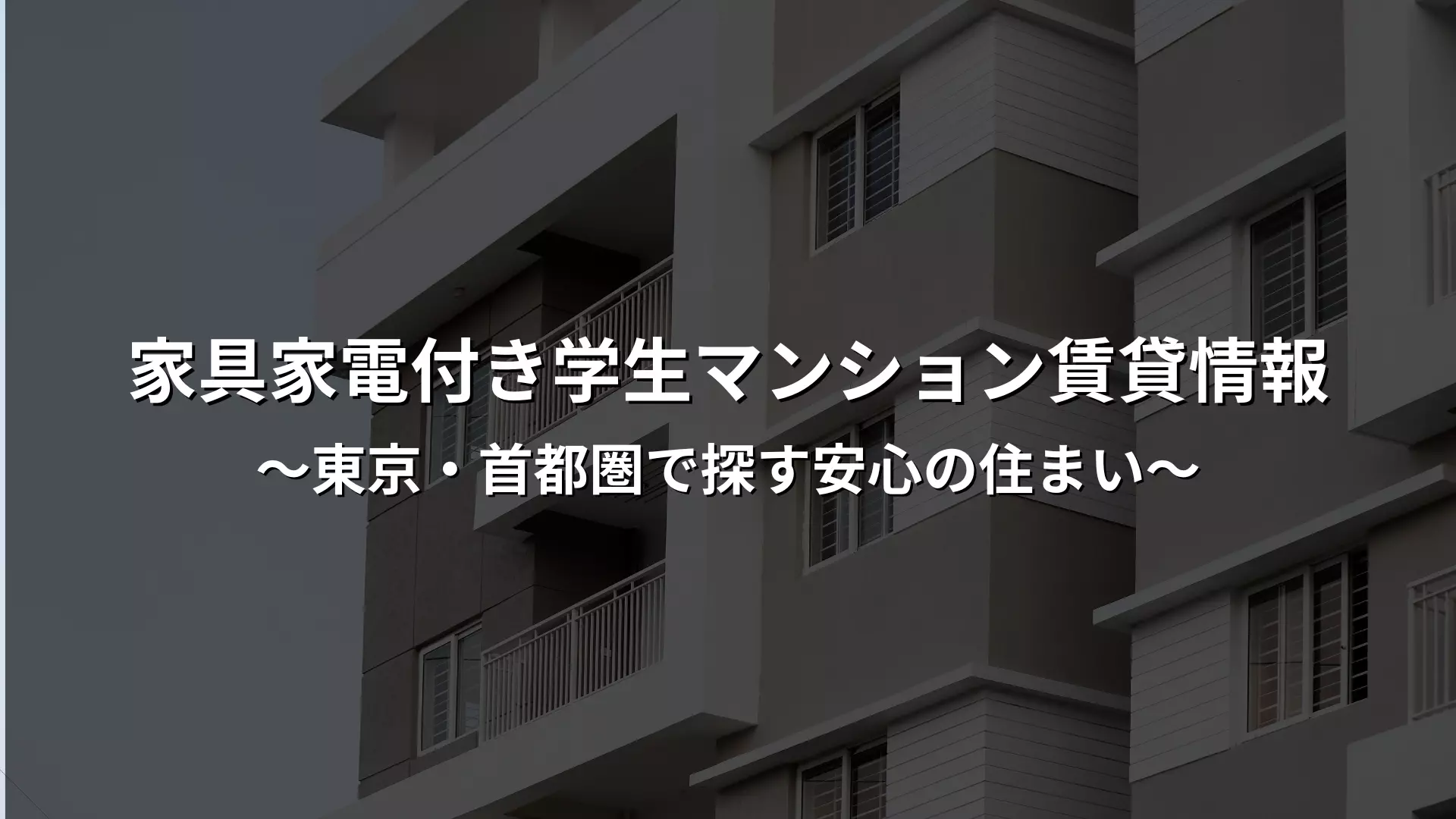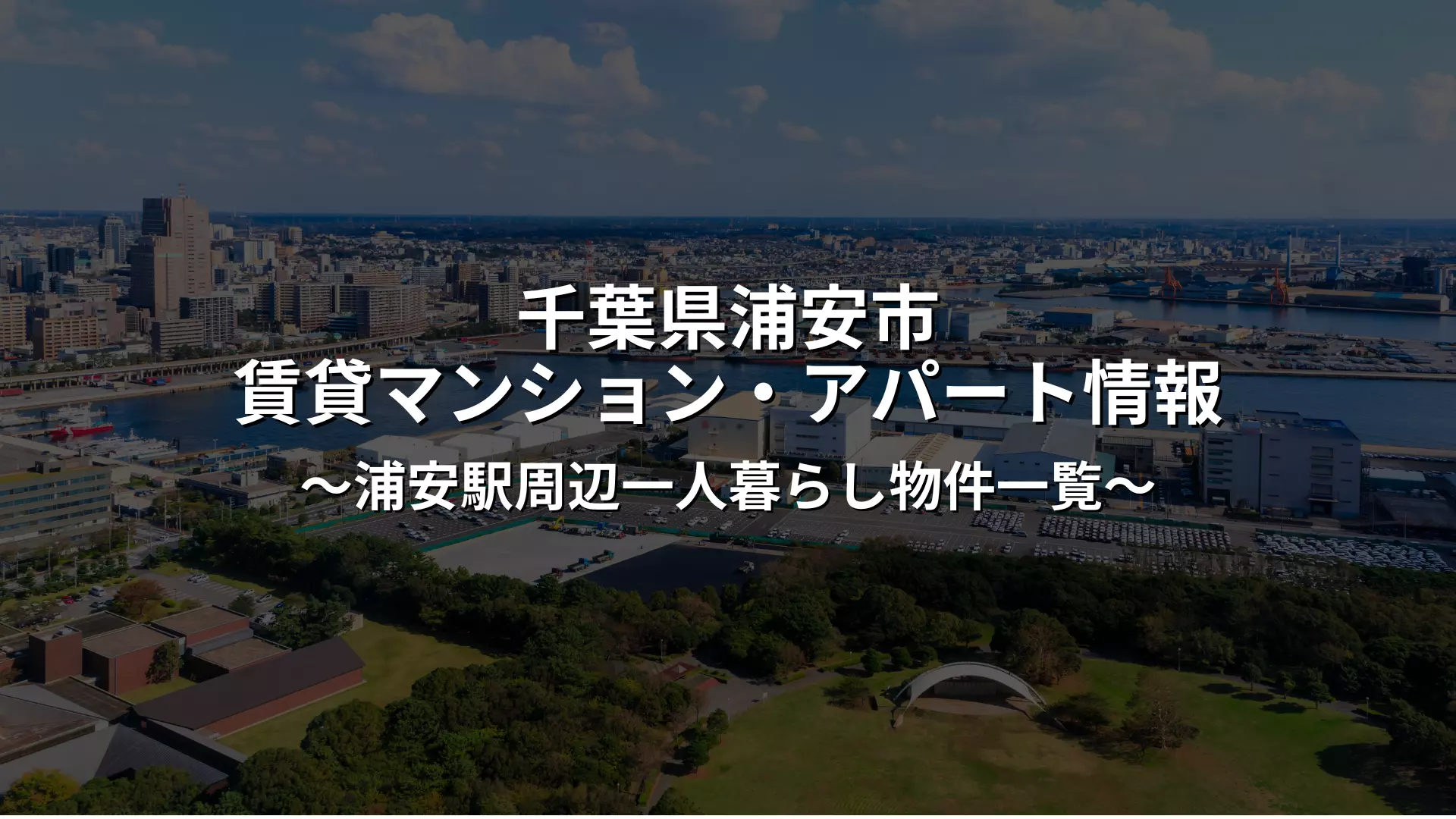What are fully furnished student apartments? Basic features and benefits
Furnished student apartments are one of the most popular housing options for students about to enter university or live alone. The main attraction is that the minimum amenities are already provided, allowing students to start a new life immediately after moving in. Various types of properties are available in each area, and are equipped with private facilities and comfortable living spaces, which not only help with your lifestyle but also your health.
Here we will introduce in detail the specific details of furnished properties and the sense of security that students feel.
Definition of furnished property and common features
A fully furnished student apartment is a property that already comes equipped with all the necessary amenities for daily life. For students living alone for the first time, having all these amenities is a major benefit. Generally, in addition to furniture such as a bed, desk, and chair, home appliances such as a refrigerator, washing machine, and microwave are already installed in the room. Some properties also come equipped with air conditioners, curtains, and lighting as standard, making it almost unnecessary to purchase additional items.
Recently, there are also more properties that come with internet access from the start, and conditions such as "free internet" and "Wi-Fi available" are also popular reasons for their popularity. By providing furniture and appliances, you can minimize the amount of luggage you need when moving, which helps reduce costs and hassle. For students starting a new life, having everything you need from the start is a big attraction, allowing them to move in with peace of mind.
Furnished with appliances, students can feel at ease
Living alone for the first time can be a mixture of anxiety and anticipation. For students leaving their hometown to continue their studies, the peace of mind of being able to live there as soon as they move in is especially important. In a fully furnished student apartment, the necessities of life such as a bed, refrigerator, and washing machine are provided from the start, so you can start living there from the day you arrive.
Another great thing about this property is that you don't have to worry about any troublesome preparations after moving in, such as installing appliances or assembling furniture. Another benefit of a property that comes with furniture and appliances is that you can keep your initial costs down. You don't have to worry about purchasing appliances or arranging for delivery, so you can significantly reduce the expenses associated with moving.
Furthermore, the facilities already installed are often regularly managed and inspected by the property owners, so you can rest assured that any troubles that may occur will be dealt with. Another attraction of student apartments is that you can live at a pace that suits your lifestyle in a room where your privacy is protected. For students, choosing a home is an important step in building the foundation of their lives. That's why furnishings and appliances are a major criterion for a property you can choose with confidence.
Student apartments in Tokyo and the greater Tokyo area
There are plenty of rental properties for students in Tokyo and the surrounding metropolitan area, and among these, student apartments with furniture and appliances are consistently popular. In particular, in areas with many universities and vocational schools, properties that are convenient and have a good living environment are noticeable. Recently built apartments and "student-only buildings" with unique features in each area are also appearing, and it is attractive that you can search from a wide range of options to suit your desired conditions.
Here, we will mainly introduce the characteristics of Tokyo's 23 wards and surrounding prefectures, the distance from the nearest station, and average rent prices.
Property characteristics by area (Tokyo 23 wards, suburbs, train lines)
Student apartments in Tokyo's 23 wards are characterized by their extremely convenient commute. Universities and vocational schools are concentrated in Shinjuku, Bunkyo, and Chiyoda wards, and there are many surrounding facilities. In these areas, many homes are available within a 10-minute walk from the nearest station, and come fully furnished with appliances. Availability varies greatly depending on the season.
Meanwhile, in the suburbs of Chiba, Saitama, and Kanagawa prefectures, there are more and more properties that offer spacious rooms and relatively low rents while still ensuring access to Tokyo. By understanding the characteristics of each train line, it will be easier to find a home that is both easy to live in and cost-effective. Depending on the area, there are apartment-type properties exclusively for students, and some buildings that emphasize shared facilities and crime prevention.
Distance from universities and vocational schools and average rent
When choosing a student apartment, the distance from the university or vocational school is an important point. Properties closer to universities in the city center tend to have slightly higher rents. In popular areas of Tokyo, recently built properties generally cost around 70,000 to 100,000 yen, but if the property is furnished with furniture and appliances, you can reduce the initial cost and ultimately keep the overall cost down.
Properties within walking distance or cycling distance tend to be popular and vacancies are limited. Therefore, if you aim for a location a little further away from the nearest station, you may be able to find a property in the 50,000 to 70,000 yen range. For students attending universities with multiple campuses or decentralized vocational schools, choosing an area that prioritizes accessibility to train lines and stations is key. Properties with furniture and appliances, like Cross House, which allow you to move flexibly while keeping rent low, are also a strong candidate.
Search for a room
Only furnished properties with appliances are listed!
How to Find and Choose a Student Apartment with Furniture and Appliances
When searching for a furnished student apartment, it is important to gather accurate information efficiently and compare the conditions. There are a wide variety of properties in Tokyo and the greater Tokyo area, with different room sizes, storage space, and facilities. Understanding the search procedures and points to check will make it easier to find a comfortable home with private facilities.
Here we will introduce the specific steps to look for a property and tips on how to choose one.
How to search the site, request information, and book a tour
The first step in finding a furnished student apartment is to start with an internet search. If you search for keywords such as "furnished student apartments in Tokyo," you will find many websites that allow you to search by criteria. There is also a system in place that allows you to narrow down your search by combining area, rent, facilities, etc., so you can efficiently compare properties that are close to your needs.
If you find a property that interests you, first make a document request to get detailed information. Checking the layout, facilities, floor area, initial costs, etc. in advance will help you avoid mismatches. In addition, we recommend making an appointment to view the property based on vacancy status and checking out the atmosphere of the actual building and rooms.
Recently, there are many ways to handle inquiries over LINE and online viewings, so you can easily make a reservation from afar. By comparing multiple properties, you're sure to find one that's right for you.
Conditions to check when comparing (rent, utility costs, internet environment, etc.)
Don't just judge a property by whether it comes with furniture and appliances, but check the cost and facilities such as rent and common area charges comprehensively. Even if the rent seems cheap, if you have to pay for water, electricity, gas, and internet, you may end up paying more. If the property has free internet or Wi-Fi, you can keep communication costs down, which will have a big impact on the total cost.
Also, pay attention to the management system and building security. Having a manager on-site and a 24-hour emergency response system will give you a sense of security. Furthermore, you should also consider details such as the grade of the furniture and appliances, the availability of storage space, the size and layout of the rooms, and other details to determine whether they will suit your lifestyle.
Small differences such as "shared washing machine" and "limited storage space" directly affect your daily comfort. Comparing information on multiple properties and carefully checking whether your necessary conditions are met will lead to choosing a property you will not regret.
Steps to moving in and points to note when signing a contract
To move into a furnished student apartment, you need to go through several steps, from applying to signing a contract and receiving the keys. For students and vocational school students who are living alone for the first time, preparing the necessary documents and understanding the charges are important points for deciding on a place to live with peace of mind.
Here we will introduce the process for moving in and the points you should check when signing a contract.

Schedule from application to moving in and necessary documents
To move into a furnished student apartment, you must first search for a property, then go through the application process and move on to the contract and handover. After checking websites and documents to find the property you want, the general procedure is to make a reservation via application form or phone, and then gather and submit the necessary documents.
Documents required at the time of signing a contract include identification, student ID, acceptance letter, and in some cases, parental income certificate, etc. Incomplete documents or delayed submission will affect the time of moving in, so it is essential to check in advance.
It is especially important to allow yourself plenty of time during the busy period from March to April, when applications are concentrated. In some cases, the process from viewing to application to contract completion can be completed in as little as one or two weeks, so the timing of your application will determine whether or not you can secure the property you want.
Points to check regarding brokerage fees and billing items
Rent and management fees are not the only costs incurred when signing a contract. There are various bills such as a deposit and key money, key exchange fees, fire insurance, and facility usage fees, so it is essential to check the breakdown. In particular, for properties that come with furniture and appliances, you may be charged an additional cleaning fee for the fixtures.
The maximum commission fee is "one month's rent + tax," but management companies that handle student properties like ours can sometimes offer discounts such as no commission or no initial fees. This is an attractive way to reduce the financial burden on students.
All information regarding costs is listed in the contract documents, so be sure to read them over and ask about any questions you may have on the spot. When signing a contract, "transparency of the contents" and "understanding of reasonable costs" will help you choose a home you won't regret.
Search for a room
Only furnished properties with appliances are listed!
Things to note and frequently asked questions about furnished student apartments
While fully furnished student apartments are convenient and provide a sense of security, there are also some things you should be aware of before signing a contract. For students signing a rental contract for the first time, being aware of the security system, management system, and ease of use of the room will help you prepare to start a healthy and comfortable new life. Here we will explain some frequently asked questions and conditions you should check before moving in.
Check whether there is a manager, 24-hour service, and security
When choosing a student apartment, security and troubleshooting systems are important criteria. Many properties are equipped with safety-conscious facilities such as auto-locks and security cameras, but another point you should check is whether or not there is a manager.
In an apartment building where a manager is always on-site, home deliveries and support in the event of trouble are handled promptly, which is reassuring for parents. In addition, if the property has a 24-hour emergency contact point, you can expect a prompt response even if there is a problem with the plumbing or if the resident is feeling unwell at night or on the weekends.
As a crime prevention measure, you should pay attention not only to the building facilities but also to the surrounding environment. Conditions such as few street lights and few people walking around can increase anxiety. In particular, if you live in a home that takes women living alone into consideration, such as a women-only floor or an apartment building with enhanced security, you can live safer.
What is the difference between a student dormitory and a private dormitory?
"Student apartments" and "student dormitories" are both housing for students, but there are big differences in how they are managed and the lifestyles they inhabit. Student dormitories are provided by educational institutions or dedicated management companies, and in many cases there are set rules about curfews, meals, and shared living, and students have less freedom in their daily lives.
On the other hand, student apartments are generally rented under a standard contract, so they offer a high degree of freedom and privacy. Even if the room comes with furniture and appliances, it is entirely your own, and the majority of apartments are one-room or one-kitchen type with a bathroom, toilet, and kitchen. Having private facilities where you can cook your own meals makes it easier to control your own lifestyle.
There are no restrictions on returning home late at night after a part-time job or visiting friends, so you can be flexible with your lifestyle, which is a big advantage for students looking for a comfortable life. Student apartments are an ideal choice for those who want to value their own time and space without being bound by rules.
Check out options other than student apartments
When choosing a place to live, students should not limit themselves to student apartments, but should consider a wide range of living options to find one that suits their lifestyle. Recently, a variety of styles have appeared, including shared houses with furniture and appliances, monthly apartments, and even regular rental properties, with a wide range of facilities, contract terms, and tenancy periods.
Particularly in Tokyo and the Kanto area, there is an increasing number of properties available for both short-term and long-term stays, making them an important option for students who want to reduce the burden of initial costs and for those who want a flexible lifestyle.
Here we will introduce in detail some typical housing options other than student apartments that you can consider.
The option of a shared house with furniture and appliances
Share houses that come equipped with furniture and appliances from the start have been gaining attention in recent years. In particular, brands such as Cross House, which is run by a listed company, offer properties aimed at students and young working adults, mainly in Tokyo's 23 wards and along train lines in the greater Tokyo area. The common areas include a living room, kitchen, and bathroom, while the rooms are completely private to ensure privacy. Some properties come equipped with security cameras and lockable rooms as standard, allowing you to live with peace of mind.
At Cross House, there is no need for a security deposit, key money, or brokerage fee, and the screening process is simple. The contract is completed online, so even those who live far away can complete the process smoothly. In addition, many properties are located within 5 to 10 minutes of a station, making it convenient for commuting to school or part-time work.
For those who are worried about living alone or who want to value interaction with others through student councils and club activities, these fully furnished shared houses offer a new style of housing that also offers excellent cost performance.
Differences between monthly and regular rentals and who is suitable for them
Monthly apartments come with furniture, appliances, and internet access, and are easy to live in for short periods of time. They are mainly used for short stays during exams, spring break, or to visit universities, and their appeal is that they keep initial costs low and allow you to start living there right away. In many cases, utilities and internet fees are included in the flat rate, making it easy to predict expenses. However, the monthly rent is somewhat high, so they may not be suitable for long-term stays.
On the other hand, regular rental properties have no restrictions on the length of stay, allowing you to live at your own pace. There are also a wide variety of floor plans to choose from, including those that can accommodate two people or standard 1K and 1DK types, allowing you to choose one that suits your lifestyle. However, it is important to note that in most cases furniture and appliances are not installed, and you will need to pay separately to purchase a refrigerator or washing machine.
As you move from high school to college or university, your housing needs will change. The key to a more fulfilling student life is to be able to choose your home flexibly, while checking the area, age of the building, and availability.
Search for a room
Only furnished properties with appliances are listed!
Summary | Enjoy a comfortable new life in a student apartment with furniture and appliances
Student apartments, equipped with furniture and appliances, are ideal housing for high school, university, and vocational school students who are living alone for the first time, and are safe to move into. Refrigerators, washing machines, lighting, and other indoor equipment are provided from the start, and moving luggage and preparations are kept to a minimum, allowing you to start your new life smoothly from the day you arrive.
The number of properties for students equipped with furniture and appliances is increasing in major cities such as Tokyo, Kanto, Tohoku, Hokkaido, Nagoya, Osaka, and Fukuoka. There are many rooms that meet popular conditions, such as those located within a 5-10 minute walk from the station and those that are relatively new. It is important to find a property that suits you by comparing various conditions, such as the average rent, commuting time, the safety of the area, whether or not there is a manager, and security facilities.
In addition to student apartments, there are a wide variety of options to choose from depending on your lifestyle and length of study, such as shared houses and monthly apartments with furniture and appliances, and student dormitories available only at affiliated schools. For example, rental services run by listed companies such as Cross House clearly display their personal information protection policies and terms of use, allowing you to sign contracts and move in with peace of mind.
Finally, if you are unsure about which property to choose, use the information-packed official websites, comparison sites, and management company information pages. By checking room availability, cost breakdowns, and videos showing detailed information about facilities, you can avoid mismatches and choose a room that satisfies you. When you move to Tokyo or go to college, be sure to start preparing early so that you can find the perfect home for you.































